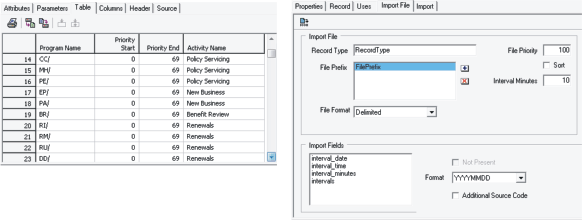


No product can provide the exact business information needed for IT Cost Transparency. RG
Solutions® was designed to allow for the tailoring of system processing by the user. This not only
results in a more business inclusive set of cost measures, but also allows for operational and other
business information to extend the IT transparency metrics further into the business.
|
|
Major Data Features |
|
Builds
|
The builds are used within the processing to define and control the creation of
information. There can be multiple builds for a single process. This allows the user
to redefine the creation process and enables different views of the information
depending on the processing need.
|
Settings
|
The Settings provide the ability for the user to control the program processing and
the formation of data. Settings can be thought of as a serious of options that is to
be used in the program processing. These options can be set to defaults or over-
ridden based on a date value. A single Settings entry may be assigned to one or
more Repository, Service, or Business Process for its associated processing.
|
Search Tables
|
Search Tables provide the ability for the user to customize the product processing
and resulting data in the simplest form. Search Tables can be thought of as a
spreadsheet type of data format that forms a set of values and rules to be used by
the program processing. When the user customizes the appropriate search table,
the program processing can produce a higher, richer content of information.
|
Properties
|
For each processing entity (Repository, Service, or Business Process), there is a
set of properties that will control the actions of the entity within the context of the
program processing. These attributes are under the complete control of the user
and can be used to establish data formation, define internal storage locations,
setup system sharing, establish archiving, and perform other options needed for
the processing environment.
|
Major Processing Capabilities
|
|
Standard
Collections
|
A standard collection is provided by the vendor and contains all the information
necessary to implement a particular type of processing. The information in a
standard collection cannot be changed, but the dynamic information that is part of
the processing can be copied and customized by the user.
|
User
Collections
|
A User Collection contains all the elements that are created by a user, and are
used to tailor the program processing to the specific requirements of the user
environment. There can be an unlimited number of user Collections available for
use, and they will be opened during program initialization. The contents of the user
collection will override the contents of the standard collection to provide the
customized processing needed for the business environment.
|
Companion
Data
|
The Companion Data processing allows the user to create processing that will
allow for localized data to be included in the program processing. The Companion
Data processing is a parameterized interface that generates the needed classes to
enable the processing. The interface allows for any type of data to be imported,
and this information can be combined with other data to form hybrid and business
centric information.
|
Custom
Services
|
Should the user need any services that they do not have the desire to perform on
their own, they can contract for the services that are needed. Under this type of
service, virtually any type of processing can be created to fulfill the business
requirements.
|